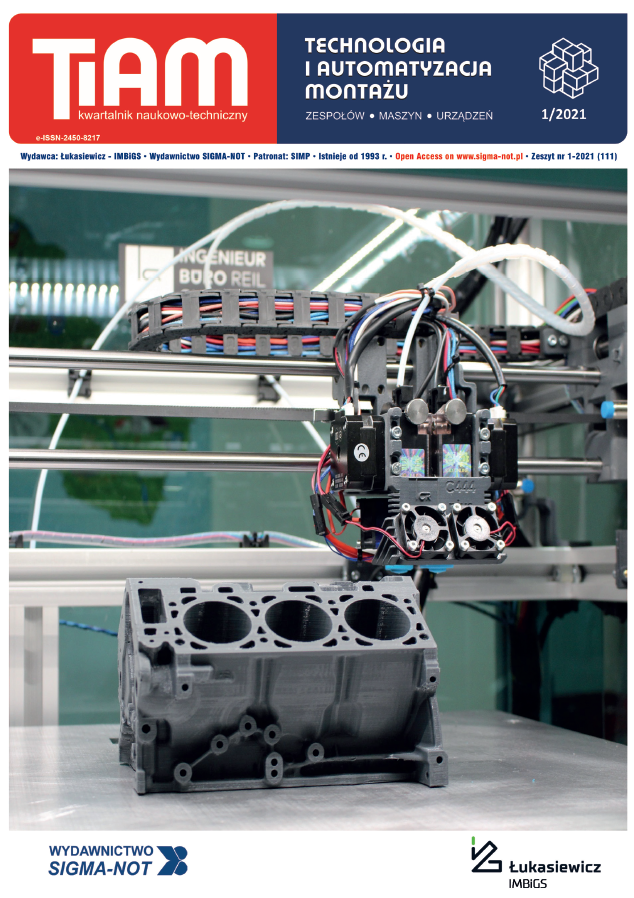Abstract
In standard lapping, the abrasive compound is feed to the machining zone in a continuous manner – either by flooding or by droplets – which generates significant loss of the abrasive. The paper describes an innovative method of dosing and applying the abrasive compound onto the surface of a lapping disc, which eliminates this drawback. Additionally, the results of the examination of the influence of the compound feed on the selected parameters of the surface roughness of ceramic elements after lapping. In the conducted experiments the Authors examined the influence of the percentage content of grinding grains in the carrier, as well as the size of the compound dosage and viscosity of a liquid carrier on the values of particular surface roughness parameters of the lapped sealing elements.
This is an Open Access article distributed under the terms of the Creative Commons Attribution License CC BY 4.0 (https://creativecommons.org/licenses/by/4.0/)
References
Bakoń A., Barylski A. 2017. Ziarna i mikroziarna dia¬mentowe. Rodzaje ścierniw i przykłady zastosowa¬nia. Gdańsk: Wydawnictwo Politechniki Gdańskiej,.
Barylski A. 2015. „Badania wpływu koncentracji ścierniwa i intensywności dawkowania zawiesiny na efekty docierania jednotarczowego”. Mechanik 8-9: 20-24.
Barylski A., Deja M. 2010. “Wear of a tool in double¬-disk lapping of silicon wafers”. [In] ASME 2010 In¬ternational Manufacturing Science and Engineering Conference, American Society of Mechanical Engi¬neers Digital Collection 1: 301-307.
Barylski A. 2013. Docieranie powierzchni płaskich na docierarkach. Gdańsk: Wydawnictwo Politechniki Gdańskiej.
Barylski A. 2013. “Technological problems in lapping on flat surfaces of ceramics parts”. Solid State Phe¬nomena 199: 627-632.
Barylski A., Gniot M. 2018. „Wpływ zawiesiny ścier¬nej dawkowanej w sposób wymuszony na wydaj¬ność docierania jednotarczowego elementów cera¬micznych”. Mechanik 8-9: 734-736.
Belkhir N., Bouzid D., Herold V. 2009. “Surface be¬haviour during abrasive grain action in the glass lap¬ping process”. Applied Surface 255(18):7951-7958.
Box G., Hunter J. 1957. “Multifactor experimental designs for exploring response surfaces”. Ann Math. Statist. 1.
Deja M., List, M., Lichtschlag L., Uhlmann E. 2019. “Thermal and technological aspects of double face grinding of Al2O3 ceramic materials”. Ceramics In¬ternational 45(15): 19489-19495.
Deja M. 2010. “Simulation Model for the Shape Er¬ror Estimation During Machining With Flat Lapping Kinematics”. [In] ASME 2010 International Manufac¬turing Science and Engineering Conference, Ameri¬can Society of Mechanical Engineers Digital Collec¬tion 1: 291-299.
Deshpande L.S., Raman S., Sunanta O., Agbaraji C. 2008. “Observations in the flat lapping of stainless, steel and bronze”. Wear 265(1-2): 105-116.
Gniot M., Barylski A., Migawa K. 2017. „System daw¬kowania zawiesiny ściernej w docieraniu powierzch¬ni płaskich”. Mechanik 10: 894-896.
Klocke F. 2009. Manufacturing Processes 2 – Grin¬ding, Honing, Lapping. Springer – Verlag,.
Liu H.K., Chen C.C., Chen W.C. 2017. “Diamond lap¬ping of sapphire wafer with addition of Graphene in slurry”. Procedia Engineering 184: 156-162.
Mańczak K. 1976. Technika planowania ekspery¬mentu. Warszawa: WNT,.
Marinescu I.D., Uhlmann E., Doi T.K. 2007. Handbo¬ok of Lapping and Polishing. Manufacturing Engine¬ering and Materials Processing. CRC Press, Taylor & Francis Group.
Polański Z. 1977. Metody optymalizacji w technologii maszyn. Warszawa: PWN.
Zong W.J., Cheng K., Sun T., Wang H.X., Liang Y.C. 2005. “The material removal mechanism in mecha¬nical lapping of diamond cutting tools”. International Journal of Machine Tools and Manufacture 45(7-8): 783-788.


